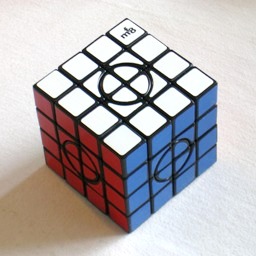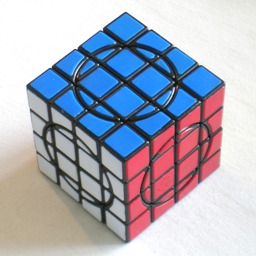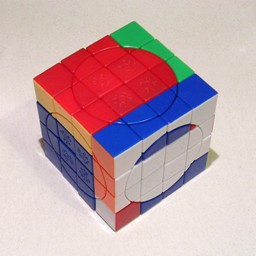Crazy 4×4×4 Cube I, II, & III
The Crazy 4×4×4 Cube is a 4×4×4 Rubik's cube where each face has a circular
region in the centre of each face that stays stationary when the outer layer is
turned. The region is as it were fixed to the inner layer.
In Crazy Cube I the radius of the circular region is smaller than the layer thickness,
so that the circle cuts each of the four square centre pieces in two.
In Crazy Cube II the circular region is just large enough to contain the four
square centre pieces, and the circle cuts a small part off each of the eight edge
pieces.
The Crazy Cube III has an even larger circular region that also cuts a small
part off each corner.
A normal 4×4×4 Rubik's Cube could be considered to have a hidden
2×2×2 cube at the core of it. It is interesting to note that the new
centre parts on the Crazy Cube I are essentially the facelets of this core
2×2×2 brought out to the surface.
The same holds for the square centre parts of the Crazy Cube II and III. The new small
edge pieces on the other hand take the place of the ordinary 4×4×4 face centres.
They move in pairs, and each pair of small pieces corresponds to an ordinary face
centre piece on a 4×4×4 supercube (i.e. a 4×4×4 where the
centre pieces of a face are distinct). On the Crazy Cube III each corner part is
moves in tandem with a pair of small edge parts, so it does not really bring
anything new to the puzzle compared to Crazy Cube II.
The number of positions:
The Crazy Cube II has 8 corner pieces with 3 orientations each,
8 core corner pieces with 3 orientations each (showing as centre facelets)
24 edge pieces, and 24 pairs of small pieces.
This gives a maximum of 8!·3
8·8!·3
8·24!·24!
positions. This limit is not reached because:
- The total twist of the corners is fixed (3)
- The total twist of the core corners is fixed (3)
- The orientation of the puzzle does not matter (24)
- The permutation of the corners and the permutation of the small piece pairs must have the same parity (2)
- The permutation of the core corners and the permutation of the edge pieces must have the same parity (2)
This leaves 8!·37·8!·37·24!·24! / 4·24 =
31,180,187,340,244,394,380,451,751,732,775,816,935,095,098,996,162,560,000,000,000 positions,
or about 3.1·1061 positions. Exactly the same holds for the Crazy Cube III
as its additional small corner parts are fully determined by the locations of the small edge
parts.
The Crazy Cube I is almost the same as II, except that instead of small edge piece pairs
we have outer face centre pieces. These come in six sets of 4 indistinguishable pieces. That
means there are 4!6 ways to invisibly rearrange them, but only even permutations
are possible while keeping the corners fixed. The Crazy Cube II therefore has 4!6/2
times as many positions as the Crazy Cube I. The Crazy Cube I then has
326,318,176,648,849,198,250,599,213,408,124,182,588,293,120,000,000,000 positions, or
about 3.23·1053 positions.
Solution:
Notation:
The same notation will be used as a 4×4×4 cube. The faces are
denoted by the letters L, R, F, B, U and D (Left, Right, Front, Back, Up
and Down). Clockwise quarter turns of a face layer are denoted by the
appropriate letter, anti-clockwise quarter turns by the letter with an
apostrophe (i.e. L', R', F', B', U' or D'). Half turns are denoted by the
letter followed by a 2 (i.e. L2, R2, F2, B2, U2 or D2). The internal slices
will be denoted by the lowercase letters l, r, f, b, u and d, and the type
of move is shown in the same way as normal face moves. Note that these
letters mean the slice only, so such a move will not disturb the corners
of the cube.
Phase 1: Solve face centres.
By turning only two layers at the same time, you treat the 4×4×4 as
if it were a 2×2×2 cube. Use any method for solving the 2×2×2
cube to put the face centre pieces correct.
The next few phases are essentially a standard "Edge Pairing" solution to
the 4×4×4 cube.
Phase 2: Solve outer centre pieces (Crazy Cube I only).
- Hold the cube so that the U face contains an unsolved centre.
- Find an outer centre piece that belongs in the U face (it matches the colour
of the U inner centres), but isn't in the U face already.
- Hold the cube so that this piece lies in the Front or Down face, while still keeping same face Up.
- Turn U to place a wrong outer centre piece at the bl position.
- If the piece you want to insert lies in the Front face, then turn F to place
the piece in the dr position and do the sequence rUr'.
If instead it lies in the D face then turn D to place the piece in the br
position and do the sequence r2Ur2.
- Repeat a-c until all four U outer centre pieces are correct.
- Repeat the steps a-f until all the centres are solved.
Phase 3: Match up the edges.
In this phase the edge pieces are matched up to form matching pairs.
- Find any edge piece that is not yet matched up with its twin edge piece.
Hold the cube so that this piece lies at the UBl location.
- Find the matching edge piece. Use any face moves to bring it to the UFr location.
- Find the edge piece that matches the UBr edge.
1. If it happens to lie at U F l, then do FU' R F'U r' U'F R' UF' r.
2. If it lies elsewhere, then bring it to the U R f location without disturbing the U F and U B edge pairs,
and do r B'RB r' to pair up the edges.
- Repeat a-c until all inner edges are paired up.
Phase 4: Solve the cube as a 3×3×3.
- Solve the cube as far as possible using any method for the 3×3×3 cube.
- There are situation that can occur that are not possible on the
normal Rubik's cube, viz. two swapped 'edges' or two swapped corners.
To fix this apparent parity problem, do the move sequence
r' F U' R F'U r l U' F R' U F' l'
which swaps the UF and UB edge pairs. The cube is now solvable like a 3×3×3 cube again.
(Note that the flipped edge pair problem cannot occur here because the inner
centres are solved.)
The Crazy Cube I is now solved. The Crazy Cube II and III however still have small outer centre
pieces that need solving.
Phase 5: Solve the centre edge pieces (Crazy Cube II and III only)
- Mix the cube up as a 2×2×2 cube, using only double layer turns. Each
'corner piece' (2×2×2 block) contains three pairs of centre pieces. One
way to remember which of these small pieces form a pair is to think of them as pointing
towards each other.
- Below is a move sequence that cycles three pairs of the centre pieces. To apply it, you need to
use double layer moves to place the three pairs you want to cycle at the locations UbR-BuR, FuR-UfR,
and LuF-UlF. Prefer to use corners with more than one unsolved pair over those with just one pair.
- To cycle UbR-BuR, FuR-UfR, and LuF-UlF, do the sequence b l b' R b l' b R'.
- Repeat steps b-c until all the centre pairs match the colours of their adjacent edges. Note that when
only a few unsolved pairs are left they might not all lie in different 2×2×2 blocks. The
preferential treatment in step b for corners with multiple incorrect pairs usually help avoid this
situation where you need to disturb already solved pairs. On the Crazy Cube III the centre corner
pieces will automatically become solved too.
- Solve the cube as a 2×2×2 cube, using only double layer turns.





